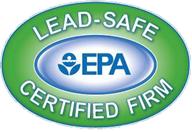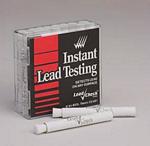Welcome to RRPedia
Your Interactive Resource for EPA RRP Information
 Looking for accurate information about the EPA RRP rule?
Looking for accurate information about the EPA RRP rule?
RRPedia has been created by Shawn McCadden to help remodelers and others affected by the New EPA Renovation Repair and Painting Rule.
Please read RRPedia Use and Contribution Information before using or contributing to RRPedia.
You Can Browse For RRP Topics By Using The Tags List To The Right
RRP Rule Could Be A Ticking Time Bomb For Many Contractors
Posted by Shawn McCadden on Sun, Dec 12, 2010 @ 12:35 PM
Topics: EPA RRP Lead Rules, OSHA Considerations, Legal Considerations, Documentation Considerations, Enforcement and Inspections
New Shawn McCadden Videos About The EPA RRP Rule; RRP Information For Renovators
 I recently completed a series of seven videos about the new EPA RRP rule. The RRP videos were done for Remodeling magazine. They are posted to the Remodeling TV area of Remodeling magazine’s web site.
I recently completed a series of seven videos about the new EPA RRP rule. The RRP videos were done for Remodeling magazine. They are posted to the Remodeling TV area of Remodeling magazine’s web site.
The videos are sponsored by The Home Depot. The video series is titled “The Insider's Guide to the EPA's Renovation, Repair and Painting Rule”. The series covers critical information about the Environmental Protection Agency's RRP rule and certification process, and explains how the rule may affect your business.
I had a lot of fun doing the videos. Lots of great people donated their time, knowledge and expertise. I also learned a lot from  writing the script, interviewing contributors, editing the script with the magazine’s editor Sal Alfano, reviewing the raw footage, and working with the videographer, Chuck Greeen of Perpetual Motion Pictures. Working with Chuck was a unique advantage. As a fellow remodeler and Certified Renovator, Chuck not only filmed and edited the videos, he also contributed greatly to the content and success of the whole project.
writing the script, interviewing contributors, editing the script with the magazine’s editor Sal Alfano, reviewing the raw footage, and working with the videographer, Chuck Greeen of Perpetual Motion Pictures. Working with Chuck was a unique advantage. As a fellow remodeler and Certified Renovator, Chuck not only filmed and edited the videos, he also contributed greatly to the content and success of the whole project.
Here is a list of the videos, a brief description of what is discussed in each as well as links to view them:
Video One: The EPA RRP Rule and Your Business
This video covers the business responsibilities, associated liabilities and risks related to the RRP Rule. Kermit Baker, Senior Research Fellow at Harvard University's Joint Center for Housing Studies stresses that remodelers need to become experts in this area or leave the work to others who are. Attorney Mike Sams of Kenney & Sams, P.C. warns about the legal liabilities for failure to follow the regulations. Shawn McCadden discusses the firm and worker certification process, related fees as well as certified renovator and firm responsibilities.
Video Two: RRP Training
This video covers the worker training requirements of the rule and the content of the EPA Certified Renovator training class. Shawn McCadden also discusses the importance and benefits of choosing a training class conducted by a training instructor with real life renovation experience.
Video Three: EPA RRP Notification Requirements
The EPA RRP rule specifies certain notification requirements depending on where the work is done and who occupies and or visits the building being renovated. This video covers these requirements, related firm documentation requirements as well as the information and documentation that must be given to property owners and others. Shawn McCadden also discusses many of the important details that must be included in the required documentation.
Video Four: RRP Work Practices
This video includes a summary of the required lead-safe work practices required under the RRP Rule. Shawn McCadden walks through critical considerations related to the rule that must be followed to stay in compliance with the rule, protect occupants and workers and to control costs. Shawn also discusses interior and exterior cleaning and cleaning verification requirements.
Video Five: RRP Record Keeping
Inspection of the required documentation under the rule will be a major enforcement tool used by EPA. In this video Shawn McCadden discusses the required documentation related to worksite activities as well as many business administration activities. Mark Paskell of the Contractor Coaching Partnership shares a few of the many methods EPA will have at their disposal to inspect and verify a firm’s compliance with the rule. Shawn adds several more methods to Mark’s list and also discusses the penalties and fines EPA can assess on violators.
Video Six: Exemptions to RRP Work Practices
In this video Shawn McCadden gives examples of when, where and why the RRP rule and work practices are not required under the rule. Shawn stresses that even if the work practices are not required under the RRP rule, your business will still be liable if lead poisoning and or contamination results from the way work is performed. Shawn and contractor insurance expert Tom Messier of Mason and Mason Insurance both stress the importance of verifying proper and adequate insurance coverage to protect your business, available coverage options as well as related costs for coverage.
Video Seven: Business Considerations and Summary
Shawn Mccadden stresses that this new rule is a game changer. Shawn tells us businesses must take this new rule seriously and adjust their business practices accordingly to protect profits and control liabilities. Mark Paskell of the Contractor Coaching Partnership stresses that contractors should verify that the documentation forms they use will comply with the rule and also assist the business in managing and performing the work. Gerry McGonagle of Belfor Property Restoration offers his advice on qualifying the right employees to do the work. Shawn also discusses some of the new responsibilities the rule brings with it for employees in all positions within the business.
If you are looking for forms and signage to help you with comply with the EPA RRP rule, I recommend you check out what The Lead Paint Forms Store has to offer.
Topics: Videos, EPA RRP Lead Rules, Worker Training, Legal Considerations, Business Considerations, Insurance Considerations, Certified Renovator Training, Documentation Considerations, EPA RRP for Dummies, Work Practices, Work Practice Exclusions, Firm Certification, Enforcement and Inspections
What States Have Taken Over The EPA RRP Rule?
Posted by Shawn McCadden on Thu, Sep 09, 2010 @ 10:38 AM
What States Have Taken Over Administration and Enforcement of The EPA RRP Rule?
Note: This post was updated on 2/28/12 to reflect information available at that time.
The National Center for Health Housing (NCHH) maintains a list tracking the status of RRP for all 50 states to help renovators and training providers. The list includes key links and highlights of rule status for each state as well as American Samoa, Guam, Puerto Rico, U.S Virgin Islands.
As of this post (updated on 2/28/12), the following states are either exploring adoption, are in process or are pending adoption of an RRP rule: District of Columbia, Illinois, Michigan, Minnesota, Missouri, Tennessee, Virginia, California
The following information can be found at the EPA web site. This information was current as of 2/28/12. Click here to check the EPA web site for the most current information.

EPA Authorized State Programs
EPA has the authority to authorize states, tribes and territories to administer their own RRP program that would operate in lieu of the EPA RRP regulations. When a state, tribe or territory becomes authorized, contractors and training providers working in these areas and consumers living there should contact the appropriate state, tribal or territorial program office.
The following states have been authorized by EPA: Alabama, Georgia, Iowa, Kansas, Massachusetts, Mississippi, North Carolina, Oregon, Rhode Island, Utah, Washington, and Wisconsin.
Information for States and Tribes
EPA headquarters has developed guidance documents to assist states and tribes that are applying to EPA for authorization to manage their own lead renovation, repair and painting programs (PDF) (122 pp, 257K).
Topics: RRP Questions, EPA RRP Lead Rules, Authorized States, Info for Landlords, RRP for Dummies, Enforcement and Inspections
EPA Releases Penalty Guidelines for RRP Enforcement
Posted by Shawn McCadden on Thu, Sep 02, 2010 @ 05:54 PM
EPA Releases Penalty Guidelines for RRP Enforcement

The EPA recently released a new government document, titled the Consolidated Enforcement Response and Penalty Policy (ERPP), laying out enforcement and penalty guidelines for the Renovation, Repair and Painting (RRP) rule. The guidelines were announced in a memorandum from Rosemarie A. Kelly, Director of the U.S. EPA Waste and Chemical Enforcement Division, on Office of Enforcement and Compliance Assurance letterhead. The memorandum was dated August 19, 2010. The new policy was created because even though the RRP ruling was issued in April 2010, enforcement and penalty issues were not clearly defined and articulated in the ruling then.
In the memorandum, Rosemarie A. Kelly states:
"This Policy sets forth guidance for Agency officials to use in determining the appropriate enforcement response and penalty amounts for violations of Section 409 of TSCA resulting from failure or refusal to comply with provisions of the Pre-Renovation Education Rule (PRE Rule); Renovation, Repair and Painting Rule (RRP Rule); and Lead-Based Paint Activates, Certification and Training Rule (LBP Activities Rule). "
 I suggest you check out the introduction section in the policy document. Although the policy document is intended to provide guidelines for EPA Enforcement staff, the document introduction also states:
I suggest you check out the introduction section in the policy document. Although the policy document is intended to provide guidelines for EPA Enforcement staff, the document introduction also states:
"Enforcement staff should continue to make appropriate case-by-case enforcement judgments, guided by, but not restricted or limited to, the policies contained in this document”
View or download the August 19, 2010 memorandum
View or download the the enforcement guidelines document (ERPP).
View or download the Final RRP Rule with Preamble
View or download the amendment regarding the Opt-Out and Record Keeping Provisions
View or download the June 18, 2010 memo delaying enforcement of certain certification requirements
Topics: EPA RRP Rule Updates, EPA RRP Lead Rules, Legal Considerations, RRP for Dummies, Firm Certification, Enforcement and Inspections
Doing EPA RRP Work? OSHA Will Be Watching For You.
Posted by Shawn McCadden on Tue, Aug 31, 2010 @ 09:00 AM
Compliance With and Enforcement of the RRP Rule Will Be Assisted By OSHA Inspectors
 In addition to the OSHA rules contractors should already have been aware of related to worker safety, the EPA RRP rule has added yet additional OSHA concerns for renovators. One for example is working on a surface covered with plastic. OSHA considerations related to working on plastic are not part of the curriculum delivered during the required EPA certified renovator training. Due to the absence of this information, the EPA is essentially leaving it up to renovators to become aware of such considerations on their own. Once aware, renovators must seek out the information they need and adjust their work practices accordingly to avoid fines from OSHA should they get randomly inspected. Or worse, have a worker accident.
In addition to the OSHA rules contractors should already have been aware of related to worker safety, the EPA RRP rule has added yet additional OSHA concerns for renovators. One for example is working on a surface covered with plastic. OSHA considerations related to working on plastic are not part of the curriculum delivered during the required EPA certified renovator training. Due to the absence of this information, the EPA is essentially leaving it up to renovators to become aware of such considerations on their own. Once aware, renovators must seek out the information they need and adjust their work practices accordingly to avoid fines from OSHA should they get randomly inspected. Or worse, have a worker accident.
 This begs a few questions. First, were the authors ignorant of such considerations? Asked another way, does the left hand know what the right hand is doing? Is this another example of a breakdown in communication between very significant departments of our government charged to look out for our best interests? A second question might be; did the authors of the EPA RRP rule leave this information out of the rule for a strategic purpose? Perhaps this is just one more way to force small independent businesses out of the construction industry in favor or labor unions.
This begs a few questions. First, were the authors ignorant of such considerations? Asked another way, does the left hand know what the right hand is doing? Is this another example of a breakdown in communication between very significant departments of our government charged to look out for our best interests? A second question might be; did the authors of the EPA RRP rule leave this information out of the rule for a strategic purpose? Perhaps this is just one more way to force small independent businesses out of the construction industry in favor or labor unions.
In one of his recent blogs, RRP certification training provider and business coach, Mark Paskell of The Contractor Coaching Partnership, shares a real life story about a contractor who was visited, at the same time, by both an OSHA inspector as well as an inspector from the Massachusetts Department of Occupational Safety (DOS). (Massachusetts has assumed administration and enforcement of the RRP rule from EOPA) In the blog Mark describes the battle that took place between the OSHA inspector and the DOS inspector about the use of plastic on the jobsite. Check out the blog to see which inspector retreated.
 Of bigger concern should be the distribution of misinformation at the certified renovator training. For example, using the sample signage included in the EPA approved training manual (required to be posted outside contained work areas), might just get you in trouble with OSHA. First off the RRP rule requires the use of a “warning” sign, but the sample sign is a “caution” sign. OSHA considers a warning sign to be a stronger message than a caution sign, and has rules dictating when and how to choose one versus the other.
Of bigger concern should be the distribution of misinformation at the certified renovator training. For example, using the sample signage included in the EPA approved training manual (required to be posted outside contained work areas), might just get you in trouble with OSHA. First off the RRP rule requires the use of a “warning” sign, but the sample sign is a “caution” sign. OSHA considers a warning sign to be a stronger message than a caution sign, and has rules dictating when and how to choose one versus the other.
Also, if you have employees, the sample sign in the manual will not meet OSHA requirements either. Employees must be told what they are being warned about on such signs, in this case lead, and the signs must also instruct the employees not to smoke, eat, or drink in a work area assumed to contain lead. Check out this article by Dick Hughes of Excellence in Safety for a list of other OSHA requirements left out of the RRP rule.
The RRP is challenging enough to comply with. Contractors putting their heads in the sand about OSHA requirements and compliance are taking a huge risk. I am planning on taking some OSHA training classes to learn more about what contractors must need to be aware of and what they will need to do to avoid risking violations and fines. I will post information about this subject to RRPedia in the future. If you have not done so already, you can subscribe to RRPedia at the top of this page. Subscribers will be notified by e-mail as soon as new articles are posted.
If you are looking for forms and signage to help you with comply with the EPA RRP rule, I recommend you check out what The Lead Paint Forms Store has to offer.
Topics: RRP in MA, Effects of the RRP Rule, EPA RRP Lead Rules, OSHA Considerations, Shawn's Predictions, Certified Renovator Training, Containment Considerations, Enforcement and Inspections
RRP Renovation Checklist Must Be Given to Certain Parties
Posted by Shawn McCadden on Thu, Aug 26, 2010 @ 05:37 PM
The RRP Renovation Checklist Must Be Given to Certain Parties At The Completion Of Renovations
 Because of one of the EPA RRP amendments, there is a new requirement regarding documentation. As of the amendment that took effect on July 6th, 2010, when the final invoice for the renovation is delivered, or within 30 days of the completion of the renovation, whichever is earlier, the renovation firm must provide information demonstrating compliance with the training and work practice requirements of the RRP rule to the owner of the building being renovated and, if different, to the occupants of the renovated housing or the operator of the child-occupied facility.
Because of one of the EPA RRP amendments, there is a new requirement regarding documentation. As of the amendment that took effect on July 6th, 2010, when the final invoice for the renovation is delivered, or within 30 days of the completion of the renovation, whichever is earlier, the renovation firm must provide information demonstrating compliance with the training and work practice requirements of the RRP rule to the owner of the building being renovated and, if different, to the occupants of the renovated housing or the operator of the child-occupied facility.
- For renovations in common areas of target housing, the renovation firm must provide the occupants of the affected housing units instructions on how to review or obtain this information from the renovation firm at no charge to the occupant. These instructions must be included in the notice provided to each affected unit or on signs posted in common areas. Similar requirements apply for renovations in child-occupied facilities.
- The renovation firm is also required to provide interested parents or guardians of children using the child-occupied facility instructions on how to review or obtain a copy of these records at no cost to the parents or guardians. This could be accomplished by mailing or hand delivering these instructions, or by including them on the signs posted.
- Renovation firms must provide training and work practice information to owners and occupants. The information should be provided in a short, easily read checklist or other form. EPA's "Sample Renovation Recordkeeping Checklist'' may be used for this purpose, but firms may develop their own forms or checklists so long as they include all of the required information.

-
The specific information that is required to be provided are training and work practice compliance information, as well as identifying information on the manufacturer and model of the test kits used, if any, a description of the components that were tested including their locations, and the test kit results.
- The checklist or form must include documentation that a certified renovator was assigned to the project, that the certified renovator provided on-the-job training for workers used on the project, that the certified renovator performed or directed workers who performed the tasks required by the RRP rule, and that the certified renovator performed the post-renovation cleaning verification.
- This documentation must include a certification by the certified renovator that the work practices were followed, with narration as applicable.
- EPA is not requiring that the renovation firm automatically provide a copy of the certified renovator's training certificate, which must be maintained in the firm's records as an attachment to the checklist or other form.
If you are looking for forms and signage to help you with comply with the EPA RRP rule, I recommend you check out what The Lead Paint Forms Store has to offer.
Topics: EPA RRP Lead Rules, Documentation Considerations, Info for Landlords, EPA RRP for Dummies, Work Practices, Amendments
For Large RRP Remodels; Renovate or Tear Down and Start Over?
Posted by Shawn McCadden on Wed, Aug 18, 2010 @ 07:19 AM
For Large RRP Remodels; Renovate or Tear Down and Start Over?
Question from an RRPedia User:

“Shawn, We have met a number of times, most recently at the Rings End event, which was great, informative and overwhelming. I'm not sure where to go for the answer to this question and thought maybe you could direct me. We are bidding a sizable remodel and the architect has note for that bidders are to follow RRP guidelines. Its pre-1978, we will be disturbing 75%+ of the existing structure and it is unoccupied. I'm thinking that we don't need to address the tarping and cleanup because of the magnitude and vacancy. If we do then we need to consider a tear down. Any guidance you can give would be appreciated. I'm sure you get this all the time so I understand if you can't get to it. Best regards, Ray Gaines Sr, Gaines Construction Co. Inc.”
Ray:
Thanks for your message. This question has come up several times already from other contractors like you who are trying to do the right thing and interpret the EPA RRP rule correctly.
The fact that the property is unoccupied during the renovation makes no difference regarding whether the EPA RRP rule applies. This is confirmed on the FAQ page of the EPA web site. Because of the removal of the opt-out provision in July of this year, any residential property where people live or will live (referred to as target housing) now requires the lead-safe practices unless the home tests out negative for lead under the EPA guidelines.
Also under the EPA RRP Rule, unless the entire interior of the structure is gutted down to bare wood, with no coated or painted surfaces remaining, the project must be treated as an RRP project and again the work must be done using lead-safe work practices. A full removal of all exterior finishes however does require the RRP Lead-safe work practices. Again, this is confirmed on the FAQ page of the EPA web site. Keep in mind, all documentation requirements apply as well.
As a side note, your message does say the building is pre 1978; however you do not say whether the property was tested for lead. If it hasn't been tested, one option to the owner would be to test it. Of course, if there is no lead, the rule would not apply.
 The EPA approved test kits sold by LeadCheck are very accurate. These tests reliably determine the presence or absence of lead. If you use these tests the owner would know if any lead is present at all. However, under the RRP Rule, the EPA says the rule exempts renovations that affect only components that a certified lead inspector or certified risk assessor has determined are free of paint or other surface coatings that contain lead equal to or in excess of 1.0 milligrams per square centimeter (mg/cm2) or 0.5% by weight. EPA further explains that the determination that any particular component is free of lead-based paint may be made as part of a lead-based paint inspection of an entire housing unit or building, or on a component-by-component basis.
The EPA approved test kits sold by LeadCheck are very accurate. These tests reliably determine the presence or absence of lead. If you use these tests the owner would know if any lead is present at all. However, under the RRP Rule, the EPA says the rule exempts renovations that affect only components that a certified lead inspector or certified risk assessor has determined are free of paint or other surface coatings that contain lead equal to or in excess of 1.0 milligrams per square centimeter (mg/cm2) or 0.5% by weight. EPA further explains that the determination that any particular component is free of lead-based paint may be made as part of a lead-based paint inspection of an entire housing unit or building, or on a component-by-component basis.
So, if the property owner wants to know if there is any lead at all, the EPA approved LeadCheck test kits could be used to do so. If the owner chooses to use the EPA's action level of lead paint amount to determine if the lead-safe practices would be required, then currently the only way to test for amount of lead would be to use a certified lead inspector or certified lead risk assessor.
 One way to think about this might be to relate it to eating fish. The government often says that if you fish in certain bodies of polluted water, you can safely eat up to so many of the fish you catch without any health concerns. If the government says you can eat up to 3 fish a year, how safe would you feel eating even one fish? Using this analogy, how safe might the owner feel having renovations done if there is any lead present at all at their property?
One way to think about this might be to relate it to eating fish. The government often says that if you fish in certain bodies of polluted water, you can safely eat up to so many of the fish you catch without any health concerns. If the government says you can eat up to 3 fish a year, how safe would you feel eating even one fish? Using this analogy, how safe might the owner feel having renovations done if there is any lead present at all at their property?
If you have opportunity to interact with the property owner, I suggest you might find you would stand out from the other bidders if you could share what I have written here with the owners. It is my opinion that the property owners should know the facts, know their options and then make a decision about how to move forward regarding lead at their homes.
Topics: RRP Questions, EPA RRP Lead Rules, Sales Considerations, Estimating Considerations, Health Effects of Lead, Compliance Options, Work Practices, RRP for Dummies, Containment Considerations, Lead Test Kits and Testing
EPA RRP Renovators May Be Blind-Sided by OSHA Requirements
Posted by Shawn McCadden on Tue, Aug 03, 2010 @ 12:39 PM
Renovators Intending to Comply With EPA RRP Rule May Be Blind-Sided by OSHA Requirements
The following article, written by Dick Hughes of Excellence In Safety, was forwarded to me last week by a colleague. Dick credits his sources at the end of the article. I also verified the accuracy of the information through one of my contacts at the Massachusetts DOS.
The article lists a variety of OSHA considerations that may likely blind-side well intentioned renovators as they attempt to comply with the new EPA RRP Rule. The RRP Rule and OSHA requirements are in conflict with each other in many ways. One EPA contact shared with me that EPA and OSHA did not collaborate on the rule while it was being written. This one consideration alone should raise serious doubt and concern for business owners about business liabilities and potential fines.
 If an EPA enforcement employee and and OSHA Field inspector show up at one of your jobsites, at the same time, there is no way you will be able to satisfy both. I suggest this is another example of shortsighted leadership within both organizations. It also points out the lack of knowledge and awareness our political leaders in Congress have as it relates to understanding the construction industry and overseeing the creation of regulations that affect businesses of all sizes.
If an EPA enforcement employee and and OSHA Field inspector show up at one of your jobsites, at the same time, there is no way you will be able to satisfy both. I suggest this is another example of shortsighted leadership within both organizations. It also points out the lack of knowledge and awareness our political leaders in Congress have as it relates to understanding the construction industry and overseeing the creation of regulations that affect businesses of all sizes.
The Article:
Big Compliance Problems Ahead for Worker Safety
On April 22, 2010, the Environmental Protection Agency (EPA) implemented a rule that requires contractors that are hired to perform renovation, repair and painting (RRP) projects in homes, child care facilities, and schools built before 1978 that disturb lead-based paint to be certified and follow specific work practices to prevent lead contamination. This rule is expected to impact hundreds of thousands of employers and millions of employees.
EPA is already proposing an expansion of this rule into pre-1978 commercial facilities. That change will significantly expand the scope of employers and building owners covered by this new regulation. Failure to comply with this new regulation can result in fines as high as $65,000 per violation, including a potential prison term. The EPA will enforce violations of the new regulation starting on Oct. 1, 2010.
The new EPA rule includes the following requirements:
• The new EPA regulations require “firms” that disturb more than 6 square feet of paint per room (or more that 20 square feet on the exterior) in these pre-1978 buildings to become certified with the EPA and employ certified renovators who would train workers and oversee these projects.
• Firms include contractors who are hired to perform renovation, repair and painting work where paint is disturbed in the targeted housing.
• Building owners whose maintenance staff also disturb painted surfaces in targeted housing must also be certified and use certified renovators.
• Certified firms must send a supervisor or “renovator” to an 8-hour class where they become certified to oversee work covered by the RRP rule.
Here’s the rub: The 8-hour class only covers the EPA requirements and completely ignores OSHA worker protection rules. Therefore, safety professionals might find that “Certified Firms” are violating OSHA lead regulations because they were not taught about OSHA requirements for worker protection. This is going to be a huge issue for employers whose employees are exposed to lead hazards during work covered by the new EPA RRP rule.
EPA Rule Doesn’t Fulfill OSHA Requirements
Employers and building owners should be alert to the fact that OSHA rules differ significantly from the EPA RRP regulations. OSHA lead regulations apply to any work where employees come into contact with any level of lead or lead bearing coatings. They should also note the following worker protection and/or OSHA omissions in the new EPA lead-based paint rule:
• Lead-based paint. The EPA RRP rule defines lead-based paint as containing more than 0.5 percent lead by weight. Lead coatings below this threshold are exempt from any special EPA certification, training or work practices. However, OSHA regulates lead in any amount. Therefore, many employers will believe that lead-coated surfaces below the EPA standards of 0.5 percent by weight are not regulated when in fact they may still be regulated by OSHA.
• Regulated areas.OSHA mandates under 1926.62 that employers establish “regulated areas” when lead or lead-coated surfaces are disturbed. A regulated area requires specific OSHA signage. The EPA signs required by their new RRP rule do not meet OSHA requirements for a regulated area.
• Written compliance program. OSHA regulations require a detailed compliance program listing specific requirements for employers to document. The EPA RRP rule does not have any requirements or discussion of a written compliance plan.
• Mandatory respirator use. OSHA lead regulations require monitoring for employees exposed to lead dust or fumes during work. OSHA has established three work class tasks for which certain exposures above the permissible exposure limit (PEL) must be assumed when employers fail to perform exposure monitoring. All of the work practices covered by the EPA RRP rule require employee respiratory protection under OSHA. However, the EPA required training only discusses respirator use as optional. The EPA training does not discuss OSHA regulations for a written respirator program, medical clearance, respirator training and fit testing for employees who are required to wear respirators.
• Protective clothing. OSHA lead regulations require protective clothing when work tasks disturb lead coatings (without a negative exposure assessment). OSHA requires either disposable clothing or employer laundering. The EPA RRP rule lists disposable clothing as optional and trains workers to use HEPA vacuums to clean clothing before going home. OSHA also requires employers to notify other employees or employers who would launder the contaminated clothing. The EPA RRP rules do not provide any awareness for employees who launder their own contaminated work clothing.
• Annual training. OSHA regulations require annual training when airborne levels of lead dust or fumes exceed their action level. EPA’s new RRP rule only requires training every 5 years.
• Hygiene facilities. OSHA regulations require a separate area to change from work clothing to street clothing as well as providing for hand/face washing facilities. The EPA does not address change facilities and suggests that workers wash their hands and face prior to leaving the work place.
• Medical surveillance and biological monitoring. OSHA mandates biological monitoring for employees exposed above the action level for airborne lead dust and fumes. The EPA RRP rule briefly mentions that the only way to detect lead in your blood is with a blood test and does not inform the workers of the OSHA requirement for biological monitoring.
The new EPA RRP lead-based paint rule is an important regulation for reducing the unacceptable levels of elevated lead in children’s blood in certain areas of the country. However, this huge piece of legislation has done a disservice to the millions of workers who will be impacted by lead during common renovation, repair, and painting activities in residential and child occupied facilities by ignoring mandatory worker protection requirements mandated by OSHA. Contractors and building owners must take extra steps to ensure that their workers or employees of contractors disturbing lead bearing substances in their facilities are thoroughly trained and protected in all applicable regulations; specifically OSHA worker protection rules for lead.
Thanks to:
Jeffery C. Camplin, MS, CSP is president of Camplin Environmental Services Inc., a safety and environmental consulting firm based in Rosemont, Ill. He is a licensed lead risk assessor and accredited EPA lead-based paint instructor for abatement courses and the new RRP rule training.
Useful links related to this article:
• July 21 Virtual Audioconference: EPA’s New Lead Paint Regulations Will Get You in Trouble with OSHA http://www.workplacetrainingcenter.com/Prod-2067.aspx
• EPA information on the new RRP rule for lead-based paint can be found at http://www.epa.gov/lead/pubs/toolkits.htm
• HUD information on lead safe work practices for renovation work can be found at http://www.hud.gov/offices/lead/training/rrp/rrp.cfm
• OSHA information on worker protection for employees exposed to lead-bearing substances can be found at http://www.osha.gov/SLTC/lead/construction.html
About the author:
Dick Hughes
Excellence In Safety
24 Spring Bars Road Falmouth, MA 02540
Web: www.excel-in-safety.com
capesafetyguy@aol.com
1-508-548-0866
cell: 1-617-653-4950
This article was originally published at Work Place Magazine
Topics: EPA RRP Lead Rules, Worker Training, Production Considerations, OSHA Considerations, Legal Considerations, Compliance Options, Work Practices, Personal Protection, OSHA - EPA Challenges, Enforcement and Inspections
EPA To Fine Window Company $784,380 for Prenotification Violation
Posted by Shawn McCadden on Mon, Jul 12, 2010 @ 09:31 AM
EPA Cites Company $784,380 for Failing to Warn Residents of Lead-Based Paint Exposures
June 20, 2010
 The U.S. Environmental Protection Agency recently filed a complaint and proposed a $784,380 penalty against Hanson’s Window and Construction Inc. of Madison Heights, Mich., for violations of the 1998 federal rule for failure to warn residents of potential lead-based paint exposures.
The U.S. Environmental Protection Agency recently filed a complaint and proposed a $784,380 penalty against Hanson’s Window and Construction Inc. of Madison Heights, Mich., for violations of the 1998 federal rule for failure to warn residents of potential lead-based paint exposures.
EPA alleges that in May 2005, Hanson, a window installation firm, failed to provide home owners and tenants of 271 residential properties in Lansing, East Lansing, Haslett, Charlotte, Onondaga, Williamston, Holt, Stockbridge, Mason, Leslie, and Warren with required information warning residents that their construction activities could expose residents to lead. The citation is based in part on information that two children living in renovated Michigan homes had tested positive for elevated blood lead levels.

The Pre-Renovation Lead Information Rule requires that renovators provide homeowners, tenants, and owners of child-occupied facilities with the “Renovate Right” pamphlet and obtain written confirmation that they have received it. The purpose of the rule is to protect families during renovations in housing built before 1978.
Lead exposure can cause reduced IQ, learning disabilities, developmental delays, reduced height, poor hearing, and other health problems in young children.
 Lead-based paint dust created during renovations is the most common source of lead exposure to children in the United States. About 75 percent of the nation’s housing built before 1978 contains lead-based paint. When properly managed, lead-based paint poses little risk. If paint is not maintained, however, even low levels of lead exposure can threaten occupants’ health, especially children and pregnant women
Lead-based paint dust created during renovations is the most common source of lead exposure to children in the United States. About 75 percent of the nation’s housing built before 1978 contains lead-based paint. When properly managed, lead-based paint poses little risk. If paint is not maintained, however, even low levels of lead exposure can threaten occupants’ health, especially children and pregnant women
This information was found at ohsonline.com
Topics: EPA RRP Lead Rules, Health Effects of Lead, Notification Considerations, Enforcement and Inspections
Personal Protection Equipment Requirements Under The EPA RRP Rule
Posted by Shawn McCadden on Mon, Jun 21, 2010 @ 07:57 AM
Question: Does the RRP rule require people working on a renovation to wear respirators, Tyvek(R) suits or other personal protective equipment (PPE)?
Most renovation contractors have little knowledge or experience with OSHA requirements. OSHA requirements concentrate on the occupational safety of the worker. There are many OSHA requirements that contractors should already be following if they use employees or sub contractors on their job sites. Because lead can create serious health risks for employees and workers, employers would be wise to become familiar with the OSHA requirements related to the work they perform under the EPA RRP rule.
The required containment methods and work practices have changed the way work gets done in the field. Even if working within OSHA requirements in the past, new activities and methods used on RRP related projects most likely trigger personal protection considerations under OSHA regulations.
Unfortunately, while creating the EPA RRP rule, the EPA did not include reference to any specific OSHA requirements. Therefore, renovators need to know and understand both the RRP rule as well as any related OSHA requirements in order to protect workers and avoid potential penalties from OSHA and or EPA. To learn more about the related OSHA requirements, renovators can refer to the OSHA Lead in Construction Standards.
 In the new MA RRP rules, still yet to be enforced as of this posting, many of the OSHA requirements related to RRP work have been included in the regulations. When I met with employees from the MA Department of Occupational Safety to discuss the proposed rule, they were very helpful in clarifying the reasons for adding these consideration. So, although the EPA and OSHA may not have collaborated when the EPA RRP rule was created, MA renovation contractors will have the advantage of knowing what OSHA requirements they will need to consider depending on the work they do as well as the methods they use to do the work. Reading the MA RRP rule would help renovators working under the EPA RRP rule identify many of the related OSHA considerations.
In the new MA RRP rules, still yet to be enforced as of this posting, many of the OSHA requirements related to RRP work have been included in the regulations. When I met with employees from the MA Department of Occupational Safety to discuss the proposed rule, they were very helpful in clarifying the reasons for adding these consideration. So, although the EPA and OSHA may not have collaborated when the EPA RRP rule was created, MA renovation contractors will have the advantage of knowing what OSHA requirements they will need to consider depending on the work they do as well as the methods they use to do the work. Reading the MA RRP rule would help renovators working under the EPA RRP rule identify many of the related OSHA considerations.
Here is EPA's response to the question at the beginning of this post:
"EPA would like to clarify the requirements for personal protective equipment. The Occupational Safety and Health Administration (OSHA) has requirements for personal protective equipment, EPA does not. For many years, EPA has recommended the use of personal protective equipment as a way to protect workers and to help ensure that leaded dust and debris does not leave renovation or abatement work sites. EPA recommends that renovators make use of the minimum respiratory protection recommended by the National Institute of Occupational Safety and Health (NIOSH) for environments where lead is present, but respiratory protection is not required by the EPA regulations. In addition, disposable clothing, if removed and disposed of before the workers leave the work site, can provide additional protection for workers' families by ensuring that no leaded dust or debris is carried home on worker clothing. However, EPA does not require this and allows renovators to use other methods to ensure that dust and debris does not leave the work area, including the HEPA vacuuming of clothing, tools, and other items before they leave the work area."
Topics: RRP Questions, RRP in MA, EPA RRP Lead Rules, OSHA Considerations, Subcontractor Considerations, Health Effects of Lead, Work Practices, Personal Protection

 The New Renovation Repair and Painting Rule could likely be a ticking time bomb for many renovators who are ignorant of, intentionally ignoring and or not following all of the many requirements of the rule. The reason I say this is because of the documentation and record keeping requirements of the RRP Rule. Renovators should keep in mind that under the rule the required documentation for each RRP project must be stored and made available for inspection for up to 3 years after the completion of the project. The EPA and or states that have taken over administration and enforcement of the rule won’t be limited to finding active violations of the rule on jobsites. They will also be able to use the required documentation to determine whether renovators were complying with the rule on all projects completed in the three years preceding an inspection. Check out this
The New Renovation Repair and Painting Rule could likely be a ticking time bomb for many renovators who are ignorant of, intentionally ignoring and or not following all of the many requirements of the rule. The reason I say this is because of the documentation and record keeping requirements of the RRP Rule. Renovators should keep in mind that under the rule the required documentation for each RRP project must be stored and made available for inspection for up to 3 years after the completion of the project. The EPA and or states that have taken over administration and enforcement of the rule won’t be limited to finding active violations of the rule on jobsites. They will also be able to use the required documentation to determine whether renovators were complying with the rule on all projects completed in the three years preceding an inspection. Check out this I had a conversation with one remodeler about the serious risks non-compliance can have for a renovator’s business. His opinion was that the risk of being caught was dependent on “how legal” the remodeler is in the way he/she operates the business. My opinion is that being legal is not measured on any kind of graduated scale. You are either operating the business legally or you are not. I think both EPA and OSHA agree with this logic.
I had a conversation with one remodeler about the serious risks non-compliance can have for a renovator’s business. His opinion was that the risk of being caught was dependent on “how legal” the remodeler is in the way he/she operates the business. My opinion is that being legal is not measured on any kind of graduated scale. You are either operating the business legally or you are not. I think both EPA and OSHA agree with this logic. 




